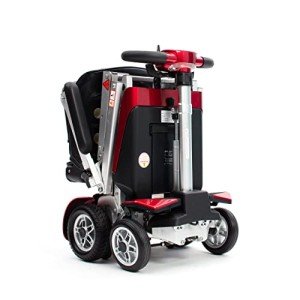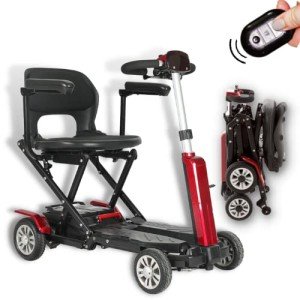The Comprehensive Guide to Folding Mobility Scooters in the UK
Folding mobility scooters are ending up being an increasingly popular option for individuals seeking mobility support in the UK. These compact and lightweight scooters provide a mix of functionality and benefit for users wanting to preserve an active lifestyle. This post dives into the different aspects of folding mobility scooters, their advantages, features, upkeep, and more.
Comprehending Folding Mobility Scooters
Folding mobility scooters are essentially portable scooters developed for easy transport and storage. Unlike conventional mobility scooters, they can be collapsed, permitting users to fit them into automobile boots, small storage spaces, or take them along in public transportation. Their lightweight building frequently enables users to operate them without the need for a ramp.
Secret Features of Folding Mobility Scooters
- Mobility: Most folding scooters can be easily carried, permitting spontaneous trips and errands.
- Lightweight Design: Weighing in between 20 to 30 kg, these scooters are developed for easy handling.
- Compact Storage: They can be folded into smaller sized measurements, ideal for those with limited space.
- User-friendly Controls: Designed for ease of usage, folding scooters often have instinctive controls.
- Resilient Construction: Built with robust materials, lots of models are appropriate for both indoor and outdoor use.
Types of Folding Mobility Scooters
Folding mobility scooters typically fall under 2 primary categories:
- Manual Folding Scooters: These scooters need the user to by hand fold and unfold them. They are often lighter and less costly.
- Automatic Folding Scooters: Equipped with electric folding systems, these scooters use improved benefit at a somewhat higher cost.
Benefits of Folding Mobility Scooters
- Mobility Independence: Users get self-reliance to travel without relying on others for help.
- Flexibility: Folding scooters are suitable for various environments, ranging from mall to park paths.
- Space-saving: Ideal for those residing in smaller sized homes or flats where storage area is an issue.
- Cost-efficient: Traveling with a folding scooter can conserve on transport costs, particularly for regular trips.
| Function | Manual Folding Disability Scooter Scooter | Automatic Folding Scooter |
|---|---|---|
| Weight | Lighter (20-25 kg) | Heavier (25-30 kg) |
| Folding Mechanism | Manual | Automatic |
| Cost | Lower expense | Greater expense |
| Mobility | High | Moderate to high |
| User Control | Hands-on | Easy push-button operation |
Factors to consider When Purchasing a Folding Mobility Scooter
1. Size and Weight Capacity
Different models include various weight limits; users need to select a scooter that can comfortably accommodate their weight. It's likewise necessary to consider the size when folded, guaranteeing it fits into the intended storage space.
2. Variety and Speed
The distance a scooter can cover on a single charge is vital. Many models range between 8 to 15 miles, while speeds normally range from 4 to 8 miles per hour. Users need to examine their travel requirements and pick appropriately.
3. Battery Type and Life
Lithium-ion batteries are typical for folding scooters as they are lightweight and offer an excellent variety. However, battery life can be impacted by elements like weight, surface, and driving style.
4. Comfort and Suspension
Try to find scooters with ergonomic styles that promote convenience throughout use. Some designs may also have suspension systems to enhance handling over unequal surfaces.
5. Warranty and Customer Support
A solid warranty and excellent consumer support can boost the user's experience and ensure comfort relating to repairs and upkeep.
Maintenance Tips for Folding Mobility Scooters
To extend the life of a folding mobility scooter, users need to comply with the following upkeep practices:

- Regular Cleaning: Keep the scooter clean to avoid dirt accumulation, which can impact performance.
- Examine Battery Levels: Monitoring the battery and charging it frequently can prevent unexpected breakdowns.
- Inspect Tires: Periodically check tire pressure and tread for indications of wear.
- Lubricate Moving Parts: Use recommended lubricants on joints and connections to ensure smooth operation.
- Seek advice from the Manual: Regularly evaluate the user manual for maintenance guidelines set out by the maker.
Frequently Asked Questions (FAQs)
1. What is the typical expense of a folding mobility scooter in the UK?
The rate of folding mobility scooters can vary substantially, usually varying from ₤ 600 to ₤ 2,500, depending on features and brand.
2. Exist age constraints for users of folding mobility scooters?
There are no particular age limitations; however, it is suggested that users are at least 14 years old, and ideal training should remain in location for more youthful users.

3. Can folding mobility scooters be used on public transportation?
The majority of folding mobility scooters can be taken on public transport, but it is best to examine particular guidelines with transport providers.
4. Are insurance and user licenses needed for folding mobility scooters?
Insurance coverage is not mandatory for privately owned scooters, however it is recommended for liability protection. As for licenses, no driving license is needed to run a mobility scooter.
5. What sort of terrain can folding mobility scooters handle?
While folding mobility scooters are created for indoor use and smooth surface areas, some models are capable of managing uneven terrain. Nevertheless, users should seek advice from specs and evaluations to guarantee they fulfill their requirements.
Folding mobility scooters serve as an invaluable resource for improving mobility and self-reliance for people with minimal mobility in the UK. With different models readily available to fit diverse requirements and preferences, users need to carefully consider their options before buying. By understanding the functions, advantages, and maintenance requirements, individuals can make an informed decision that improves their way of life and flexibility.
